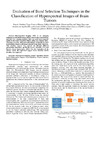Identificador persistente para citar o vincular este elemento:
https://accedacris.ulpgc.es/jspui/handle/10553/77466
| Título: | Evaluation of band selection techniques in the classification of hyperspectral images of brain tumors | Autores/as: | Martínez Vega, Beatriz | Director/a : | Marrero Callicó, Gustavo Iván Fabelo Gómez, Himar Antonio Ortega Sarmiento, Samuel |
Clasificación UNESCO: | 3325 Tecnología de las telecomunicaciones | Fecha de publicación: | 2019 | Proyectos: | Hyperspectral Imaging Cancer Detection (Helicoid) (Contrato Nº 618080) | Resumen: | The main objective of this Master Thesis is to study and evaluate different band selection algorithms in order to identify the most relevant bands in hyperspectral (HS) images to allow an accurate delineation of brain tumors during surgical procedures. The employed HS database was composed of 26 HS images of in-vivo human brain obtained during neurosurgical procedures. For each image, a certain number of pixels were labeled in four different classes in order to create a labeled dataset, employed to develop and evaluate a classification model following a leave-one-patient-out cross-validation methodology using 6 test HS images. Four types of classes were defined: normal tissue, tumor tissue, hypervascularized tissue and background. During the development of the project, different methodologies were carried out. Firstly, the most representative bands for each test HS image with different optimization algorithms were selected. After identifying these bands, all test images were evaluated using the coincident bands between the obtained results. The process starts by evaluating the test images with all the bands selected, then employing the bands that were repeated in at least two test images, and so on until reaching the maximum number of coincident levels in each case. Once this extensive evaluation was carried out, it was decided which set of bands were the ones that provided the most relevant information. The evaluation metrics employed in these experiments were: overall accuracy, sensitivity, specificity, Matthews correlation coefficient and the qualitative classification maps. The results obtained with the band selection algorithms were compared with the reference results employing all the bands in the HS images. The results demonstrate that the proposed methodology based on the Genetic Algorithm optimization method improves the accuracy results in identifying different classes for brain cancer detection application, employing only 48 bands. The most relevant spectral ranges identified were: 440.5-465.96 nm, 498.71-509.62 nm, 556.91-575.1 nm, 593.29-615.12 nm, 636.94-666.05 nm, 698.79-731.53 nm and 884.32-902.51 nm. | Facultad: | Escuela de Ingeniería de Telecomunicación y Electrónica | Instituto: | IU de Microelectrónica Aplicada | URI: | https://accedacris.ulpgc.es/handle/10553/77466 |
| Colección: | Trabajo final de máster |
En el caso de que no encuentre el documento puede ser debido a que el centro o las/os autoras/es no autorizan su publicación. Si tiene verdadero interés en el contenido del mismo, puede dirigirse al director/a o directores/as del trabajo cuyos datos encontrará más arriba.
Vista completaVisitas
98
actualizado el 11-may-2024
Descargas
67
actualizado el 11-may-2024
Google ScholarTM
Verifica
Comparte
Exporta metadatos
Los elementos en ULPGC accedaCRIS están protegidos por derechos de autor con todos los derechos reservados, a menos que se indique lo contrario.


